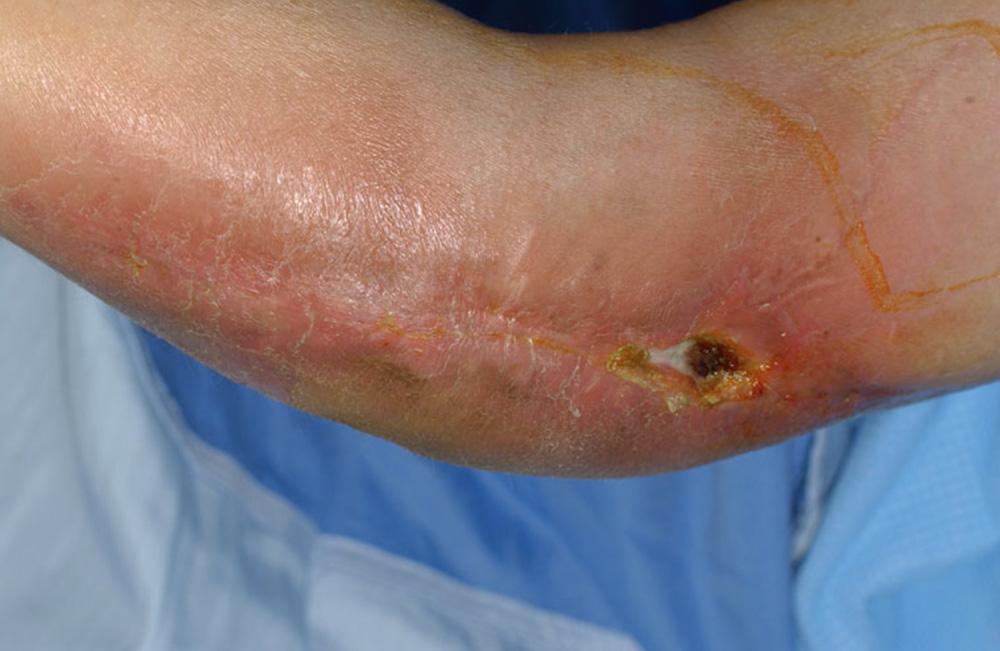Physical Address
304 North Cardinal St.
Dorchester Center, MA 02124
Infection after total elbow arthroplasty (TEA) is a common and devastating complication, with rates from 0 to 14% in clinical series. a
a References .
Despite the increasing procedure volume of TEA, no clear guidelines exist for the diagnosis of periprosthetic joint infection (PJI) in the elbow. Increasing research attention to this topic in the last 5 years has provided better data for clinical decision making. However, evidence remains scarce, and hard diagnostic criteria are lacking. The objective of this chapter is to review relevant published data and report the authors' preferred algorithm for the diagnosis of elbow PJI.
Initial reports of TEA showed very high infection rates, as Morrey and Bryan reported a 9% incidence of deep infection among 156 elbow replacement procedures. This has appeared to decrease over time in the experience of the senior author, possibly due to the use of antibiotic-impregnated cement, postoperative immobilization for 24 to 36 hours, and improvements in surgical technique. Despite this, the rates remain higher than those seen in hip and knee arthroplasty. A systematic review by Voloshin et al. found the weighted mean incidence of elbow PJI from 1993 to 2009 to be 3.3%. The increased incidence of elbow PJI compared with that of the hip and knee has been attributed to the thin soft tissue envelope of the elbow, the poor quality of the soft tissue envelope due to multiple prior surgical procedures, and immunocompromise secondary to medical treatment.
Several risk factors have been identified in the literature for elbow PJI. A history of multiple surgical procedures about the elbow before the index arthroplasty has been shown to increase the likelihood of infection. Prosthetic infection rates were found to be higher in patients with a prior infection or any history of postoperative drainage or early wound complications. The association of elbow PJI with disease-modifying antirheumatic drugs has not been independently demonstrated. However, the overall increased infection risk after orthopedic surgery in patients treated with these medications should prompt concern (see Chapters 77 and 91 ).
Baghdadi et al. performed a retrospective review of 723 TEA procedures and analyzed the effects of obesity on outcomes. Although mechanical failure and aseptic loosening were more common among the obese patients, deep infection rates were not significantly different. However, a case series of 51 consecutive TEA procedures showed a higher mean body mass index (BMI) of patients with deep infection (mean BMI 34.5 kg/m 2 ) compared with noninfected patients (mean BMI 27.2 kg/m 2 ). Some commonly assumed risk factors for PJI such as diabetes and inflammatory conditions have not been independently associated with elbow prosthetic infection. A recent review of the National Inpatient Sample by Pope et al. showed increased incidence of wound infections among diabetic patients on univariate analysis, but multivariate regression showed that diabetes was not an independent risk factor for perioperative complications when age and other comorbidities were considered. As is well known, absence of evidence is not evidence of absence, and further prospectively gathered data are needed to assess these risk factors.
Similarly to the shoulder, systemic reports of fever or malaise are not universally seen in patients with elbow PJI. Instead, clinical findings such as persistent pain or stiffness without a clear cause should raise suspicion of infection. Pain at rest and/or at night, lack of pain relief or only a brief period of pain relief after surgery, and progressive loss of motion also warrant further investigation. Infection may also present as loosening or failure that is earlier than expected. Occasionally, patients may present with draining sinuses ( Fig. 100.1 ).

PJI of the elbow may be classified into acute (less than 3 months postoperatively), subacute (between 3 months and 1 year postoperatively), and late (more than 1 year postoperatively) infection. Spormann et al. demonstrated no recurrences after débridement and implant retention among patients who received a diagnosis in the acute phase compared with a 60% recurrence rate for patients who received a diagnosis in the late phase; they recommended a débridement and retention strategy among late infections only in cases of acute-on-chronic symptom onset with fewer than 10 days from symptom onset to treatment.
Become a Clinical Tree membership for Full access and enjoy Unlimited articles
If you are a member. Log in here